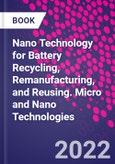Nanotechnology for Battery Recycling, Remanufacturing, and Reusing explores how nanotechnology is currently being used in battery recycling, remanufacturing and reusing technologies to make them economically and environmentally feasible. The book shows how nanotechnology can be used to enhance and improve battery recycling, remanufacturing and reusing technologies, covering the fundamentals of battery recycling, remanufacturing and reusing technologies, the role of nanotechnology, the separation, regeneration and reuse of nanomaterials from battery waste,� nano-enabled approaches for battery recycling, and nano-enabled approaches for battery remanufacturing and reusing.
This book will help researchers and engineers to better understand the role of nanotechnology in the field of battery recycling, remanufacturing and reusing. It will be an important reference source for materials scientists and engineers who would like to learn more about how nanotechnology is being used to create new battery recycling processes.
Please Note: This is an On Demand product, delivery may take up to 11 working days after payment has been received.
Table of Contents
Part 1: Introduction 1. Types of batteries in market and their statistics 2. Nanomaterials in batteries 3. Closed loop in battery recycling, remanufacturing, and reusing 4. Nanotechnology and recycling, remanufacturing, and reusing battery 5. Available technologies for recycling, remanufacturing, and reusing batteries: An introduction 6. Underdevelopment and promising technologies of recycling, remanufacturing, and reusing batteries: An introduction 7. Modeling and analysis tools for recycling, remanufacturing, and reusing batteries: An introduction
Part 2: Recycling, Remanufacturing and Reusing Batteries 8. Environmental aspects of recycling, remanufacturing, and reusing batteries 9. Economical aspects of recycling, remanufacturing, and reusing batteries 10. Safety aspects of recycling, remanufacturing, and reusing batteries 11. Government supports and incentive programs for recycling, remanufacturing, and reusing batteries 12. Regulations and standards for recycling, remanufacturing, and reusing batteries 13. Disassembly of battery packs for recycling 14. Industry experience in recycling, remanufacturing, and reusing batteries
Part 3: Nanotechnology for Battery Recycling 15. Mechanical and physical processes of battery recycling and the role of nanotechnology 16. Pyrometallurgical processes of battery recycling and the role of nanotechnology 17. Hydrometallurgical processes of battery recycling and the role of nanotechnology 18. Emerging processes and technologies of battery recycling and the role of nanotechnology 19. Separation technologies of nanomaterials from batteries 20. Regeneration technologies of nanomaterials of recycled batteries 21. Equipment for recycling batteries and separation of nanomaterials 22. Potential environmental impacts of non-recycled battery nanomaterials 23. Battery design to improve its recyclability
Part 4: Recycling Battery Components and Nanomaterials 24. Recycling battery cathode materials 25. Recycling battery anode materials 26. Recycling battery electrolyte materials 27. Recycling battery current collector materials 28. Recycling of battery casing materials 29. Recycling battery polymer materials 30. Recycling battery ceramic materials 31. Recycling battery metallic materials 32. Recycling lithium, cobalt, and nickel and returning to battery production cycle
Part 5: Battery Remanufacturing and Reusing from Recycled Nanomaterials 33. Battery manufacturing from recycled nanomaterials 34. Blending fresh and recycled nanomaterials in battery manufacturing 35. Applications of batteries made from recycled nanomaterials 36. Safety of batteries made from recycled nanomaterials 37. Current and future market for batteries made from recycled nanomaterials 38. Performance of batteries made from recycled nanomaterials 39. Industry experience in using batteries made from recycled nanomaterials 40. Future trends and threats for remanufacturing and reusing batteries from recycled nanomaterials
Authors
Siamak Farhad Associate Professor, Department of Mechanical Engineering, The University of Akron, Ohio, USA. Siamak Farhad is Associate Professor in the Department of Mechanical Engineering, at The University of Akron,Ohio, USA. His primary and secondary research fields are energy and measurement, with a focus on energy, both energy conversion and storage, with particular emphasis on batteries, fuel cells, and piezoelectrics, from nano/microstructure design to the cell, device and system design. His focus in the field of measurement is on new sensors, is interdisciplinary and linked to nanotechnology, electrochemistry, thermal science, and material science. His research is based on both modeling and experiment; the selected research topics are, recycling and regeneration of lithium-ion battery materials, optimization of electrodes nano/microstructure for lithium battery, ceramic solid-state lithium battery, and piezoelectric materials for sensor and energy harvester. Ram K. Gupta Professor, Department of Chemistry, Kansas Polymer Research Center, Pittsburg State University, Pittsburg, KS, USA. Ram K. Gupta is a Professor in the Department of Chemistry at Pittsburg State University, USA. His research interests include green energy production and storage using conducting polymers, 2D materials, nanostructured materials and composites, polymers from renewable resources for industrial applications, polymer recycling for sustainable future, bio-compatible nanofibers and thin films for tissue regeneration, scaffolds, bio-degradable metallic implants, and antibacterial applications. Ghulam Yasin Researcher, School of Environment and Civil Engineering, Dongguan University of Technology, Guangdong, China. Ghulam Yasin is a researcher in the School of Environment and Civil Engineering at Dongguan University of Technology, Guangdong, China. His expertise covers the design and development of hybrid devices and technologies of carbon nanostructures and advanced nanomaterials for for real-world impact in energy-related and other functional applications. Tuan Anh Nguyen Senior Principal Research Scientist, Institute for Tropical Technology, Vietnam Academy of Science and Technology, Hanoi, Vietnam. Tuan Anh Nguyen is Principal Research Scientist at the Institute for Tropical Technology, Vietnam Academy of Science and Technology, Hanoi, Vietnam. His research focuses on advanced nanomaterials and nanotechnology for corrosion and materials integrity in transportation systems. His research activities include smart coatings, conducting polymers, corrosion and protection of metals/concrete, antibacterial materials, and advanced nanomaterials.








